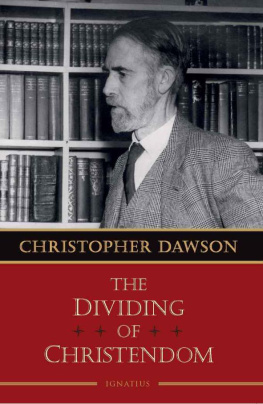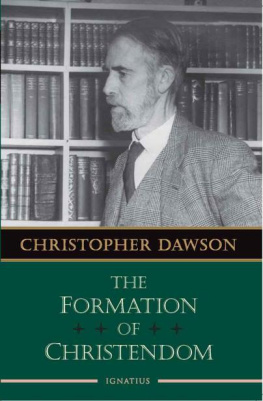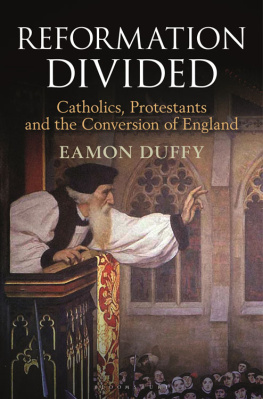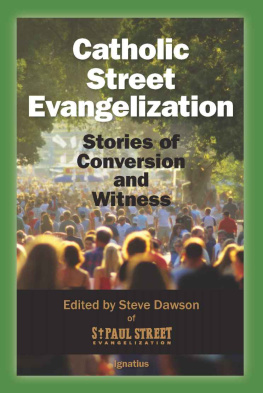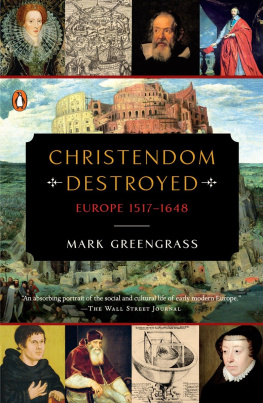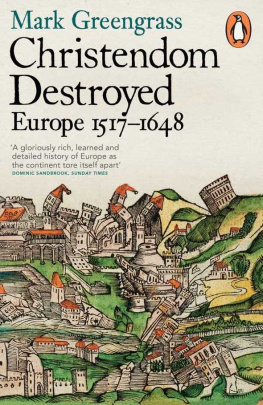THE DIVIDING OF CHRISTENDOM
The Dividing of
CHRISTENDOM
CHRISTOPHER DAWSON
IGNATIUS PRESS SAN FRANCISCO
Originally published by Sheed & Ward, New York, 1965
First English edition published by Sidgwick and Jackson Ltd,
London, 1971
Julian Philip Scott 2008
Literary Executor of the Estate of Christopher Dawson
Reprinted by permission of Mr. Julian Philip Scott
All rights reserved
Cover photograph:
Christopher Dawson, Oxford, ca. 1952
Courtesy of the Department of Special Collections,
University of St. Thomas, St. Paul, Minn.
Cover design by Roxanne Mei Lum
Reprinted in 2009 by Ignatius Press, San Francisco
ISBN 978-1-58617-238-1
Library of Congress Control Number 2007938145
Printed in the United States of America
PUBLISHERS NOTE
After the death of Christopher Dawson in May 1970 it was felt that some of his works which had never appeared in England before should be published.
The present volume consists of a selection from the lectures the author gave at Harvard during the years 1958 to 1962 when he was the first occupant of the Chair of Roman Catholic Studies, founded by Charles Chauncey Stillman.
The theme of the lectures was Christendom and they fell naturally into three groupsThe Formation of Christendom, The Dividing of Christendom, The Return to Christian Unity. The present book contains all the lectures of the second group covering the period from the Reformation to the Age of the Enlightenment.
NOTE ON THE IGNATIUS PRESS EDITION
Some minor changes to spelling and punctuation have been made to the text.
To Chauncey Stillman
CONTENTS
FOREWORD TO THE 2009 EDITION
The Dividing of Christendom (1965) and The Formation of Christendom (1967) were the last of Christopher Dawsons books to be published in his lifetime. (The Gods of Revolution [1972] was published posthumously.)
Raised a devout Anglican, and converting to the Catholic Church only after long study, Dawson (1889-1970) had a deep personal interest in religious divisions. His chief apologia for his conversion was in his 1933 book The Spirit of the Oxford Movement , where he confirmed John Henry Newmans judgment that the crucial issue was not Protestantism versus Catholicism but belief versus unbelief. Newman found Protestantism was unable to confront unbelief because of its reliance on private judgment rather than on a magisterium.
Dawson himself found the absence of theological principles to be the very nature of Anglicanism, which used Anglo-Catholic liturgical practices to conceal theological modernism, a state of affairs which required Anglicans who did have principles to convert to Rome.
Despite these severe judgments, Dawson was an early ecumenist, often lamenting the scandal of Christian disunity and warning that, because the Church lacked the capacity to mold and inspire, men would look elsewhere for guidance. This situation demanded efforts towards religious reunion.
However, Dawson could never accept doctrinal compromise as the price of reunion and, to avoid that, consistently argued that social obstacles and the unconscious clash of cultures had more to do with religious divisions than beliefs did. He contended that most schisms and heresies were rooted in social or national antipathies, and, if theologians had understood that fact, the history of the Church would have been very different. By promoting the virtues of faith, hope, and charity, Christians could perhaps remove these hidden obstacles.
The Jesuit historian James Brodrick once charged that Dawsons approach seemed Marxist and asked, Does theology count for so little? Dawson replied that it was a dubious compliment to theology to hold it responsible for heresy and schism, but he conceded that religious divisions did involve genuine theological problems. The illusion of easy reunion erred in its indifference to theological issues, but the rigidity of theological beliefs on both sides prevented people from seeing what they had in common.
During World War II, Dawson served as vice-president of The Sword of the Spirit, an ecumenical group formed to work for the spiritual revitalization of Great Britain. He edited The Swords newsletter and defined the groups purpose as the coordination of spiritual forces, an attempt to fill the gap between the Church and the secular state and to create a framework of international cooperation, a crusade against totalitarianism on a spiritual rather than a political plane.
Some Catholic theologians objected to Catholics and Protestants even saying the Lords Prayer together, but Dawson warned that this attitude made it seem that Catholics did not consider Protestants to be Christian. He explained that he employed the phrase common prayer and sacraments merely in the sense that similar forms were used by almost all Christian groups. He did not imply equivalency among these forms but merely stated an objective fact.
It was not permissible to assume that Protestant beliefs and practices meant nothing, since they were potential avenues of return to the supernatural. This return could be achieved first by the reconversion of heretics and schismatics and then by the conversion of the whole world. There was a theological foundation for a common faith, although it was not clear what precisely this foundation was. The Holy Spirit and the kingdom of Christ were wider than the Catholic Church, and the Church itself had condemned the exclusivist interpretation of outside the Church there is no salvation.
After the war, Dawson warned that relations with non-Catholics were even more necessary, that it was necessary to move to the higher ground of faith and revelation and to the mystery of the unity of the church. The era of disunity was coming to an end. Theological controversies were mainly an inheritance from the past and were not relevant to the future, since historically theology had often been a cover for other issues. Unity was not to be achieved by conceding doctrinal points but rather by acceding to Gods will.
Dawsons ecumenism was based on faith in Christ, which precluded his taking an ecumenical stance towards non-Christian religions. He defined his position through his dialogues during the 1950s with an English Benedictine monk, Bede Griffiths, who had moved to India and was deeply sympathetic to Hinduism.
The two men agreed that Hinduism could be a preparation for Christ, yet they disagreed on Griffiths theory of primitive revelationthe idea that God had communicated knowledge of himself to various peoples even before the Bible and other sacred books had been written. Dawson argued that such was not divine revelation but merely natural religion, mankinds subjective religious perceptions. Eastern religions lacked theological truth, although they did possess natural theology and natural law, which underlay all primitive cultures.
In The Dividing of Christendom , Dawson elaborated his thesis that cultural and social differences might be the ultimate root of apparent religious disagreement. (In order to understand his views fully, the book should be read in conjunction with The Movement of World Revolution [1959].)
Teaching at Harvard University on the eve of the Second Vatican Council, he rejoiced that God is undoing the social consequences of the Reformation by placing Catholics and Protestants together in the same land.
Reunion was not imminent, but schism was the worst of evils because it thwarted Gods plan for unity. Real dialogue was taking place, and there were new trends towards Protestant unity, which, although they were unlikely to bridge the ProtestantCatholic gap, might culminate in two worldwide religious communitiesCatholic and Protestantorganized not against each other but against a godless world.
By attributing religious divisions primarily to non-religious factors, he made it possible to encourage ecumenical cooperation, even though he probably assumed that ecumenism ultimately meant a return to the Catholic Church.
Next page
